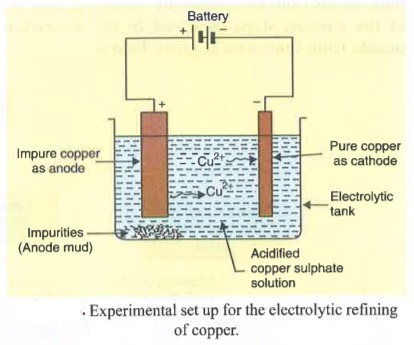Complete Solutions to Exercise of chapter METALS AND NON-METALS of Class 10 book with complete answers and questions
| Class 10 | CHEMISTRY |
| Chapter | METALS AND NON-METALS |
| NCERT | Exercise |
| Number Of Questions | 30 |
| Academic Year | 2023-24 |
Explain the meaning of malleable and ductile.
03:15View SolutionWhy is sodium kept immersed in kerosene oil?
01:29View SolutionWrite equations for the reactions of
(i) iron with steam
(ii) calcium and potassium with water02:27View SolutionSamples of four metals A, B, C and D were taken and added to the following solution one by one. The results obtained have been tabulated as follows.

Use the Table above to answer the following questions about metals A, B, C and D.
(i) Which is the most reactive metal?
(ii) What would you observe if B is added to a solution of Copper (II) sulphate?
(iii) Arrange the metals A, B, C and D in the order of decreasing reactivity.View SolutionWhich gas is produced when dilute hydrochloric acid is added to a reactive metal? Write the chemical reaction when iron reacts with dilute `H_(2)SO_(4).`
View SolutionWhat would you observe when zinc is added to a solution of iron (II) sulphate?
Write the chemical reaction that takes place.01:08View Solution(i) Write the electron-dot structures for sodium, oxygen and magnesium.
(ii) Show the formation of `Na_(2)O` and `M_(g)O` by the transfer of electrons.
(iii) What are the ions present in these compounds?03:11View SolutionWhy do ionic compounds have high melting points?
View SolutionDefine the following terms.
(i) Mineral
(ii) Ore
(iii) GangueView SolutionName two metals which are found in nature in the free state.
View SolutionWhat chemical process is used for obtaining a metal from its oxide?
View SolutionMetallic oxides of zinc, magnesium and copper were heated with the following metals.

In which cases will you find displacement reactions taking place?View SolutionWhich metals do not corrode easily?
View SolutionWhat are alloys?
01:02View SolutionWhich of the following pairs will give displacement reactions?
(i) `NaCl` solution and copper metal
(ii) `MgCl_(2)` solution and aluminium metal
(iii) `FeSO_(4)` solution and silver metal
(iv) `AgNO_(3)` solution and copper metal03:49View SolutionWhich of the following methods is suitable for preventing an iron frying pan from rusting?
(a)Applying grease
(b) Applying paint
(c) Applying a coating of zinc
(d) All of the above02:13View SolutionAn element reacts with oxygen to give a compound with a high melting point. This compound is also soluble in water. The element is likely to be
(a) calcium
(b) carbon
(c) silicon
(d) iron02:31View SolutionFood cans are coated with tin and not with zinc because
(a) zinc is costlier than tin.
(b) zinc has a higher melting point than tin.
(c) zinc is more reactive than tin.
(d) zinc is less reactive than tin02:04View SolutionYou are given a hammer, a battery, a bulb, wires and a switch.
(a) How could you use them to distinguish between samples of metals and non-metals?
(b) Assess the usefulness of these tests in distinguishing between metals and non – metals.02:15View SolutionWhat are amphoteric oxides? Give two examples of amphoteric oxides.
03:05View SolutionName two metals which will displace hydrogen from dilute acids, and two metals which will not.
02:47View SolutionIn the electrolytic refining of a metal M, what would you take as the anode, the cathode and the electrolyte?
03:41View SolutionPratyush took sulphur powder on a spatula and heated it. He collected the gas evolved by inverting a test tube over it, as shown in figure below.

(a) What will be the action of gas on
(i) dry litmus paper?
(ii) moist litmus paper?
(b) Write a balanced chemical equation for the reaction taking place.03:04View SolutionState two ways to prevent the rusting of iron.
01:35View SolutionWhat type of oxides is formed when non-metals combine with oxygen?
01:41View SolutionGive reasons
(a) Platinum, gold and silver are used to make jewellery.
(b) Sodium, potassium and lithium are stored under oil.
(c) Aluminium is a highly reactive metal, yet it is used to make utensils for cooking.
(d) Carbonate and sulphide ores are usually converted into oxides during the process of extraction.01:58View SolutionYou must have seen tarnished copper vessels being cleaned with lemon or tamarind juice. Explain why these sour substances are effective in cleaning the vessels.
01:45View SolutionDifferentiate between metal and non-metal on the basis of their chemical properties.
01:43View SolutionA man went door to door posing as a goldsmith. He promised to bring back the glitter of old and dull gold ornaments. An unsuspecting lady gave a set of gold bangles to him which he dipped in a particular solution. The bangles sparkled like new but their weight was reduced drastically. The lady was upset but after a futile argument the man beat a hasty retreat. Can you play the detective to find out the nature of the solution he had used?
02:25View SolutionGive reasons why copper is used to make hot water tanks and not steel (an alloy of iron).
02:23View Solution
Exercise questions and complete solutions for chapter METALS AND NON-METALS of NCERT CHEMISTRY(ENGLISH) of Class 10
